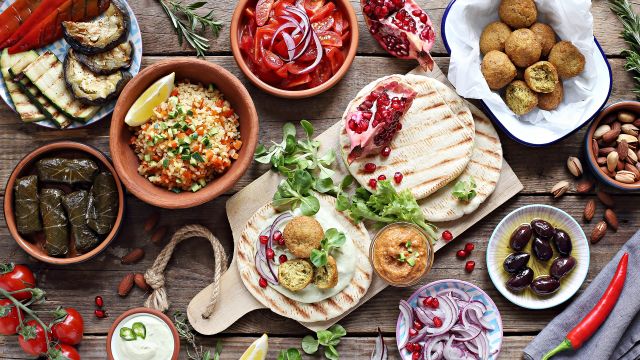When you’ve been diagnosed with diabetes, knowing what to eat suddenly becomes a Very Big Deal. Forget about casually grabbing a cookie in the break room or having a snack whenever you feel like it. Now you have to think about your eating pattern. That’s a fancy term for your diet—the foods and beverages you consume on a daily basis. Luckily, your medical team is trained to help you find the eating pattern that’s right for you.
“The best diet is one that’s tailored to the individual,” says Rachel Marcucci, MD, an internist and pediatrician at St. Joseph Mercy Health System in Livonia, Michigan. Your doctor should refer you to a dietitian for medical nutrition therapy, which is covered by Medicare and many private insurance plans. “There’s really no reason not to do it,” she says.
The American Diabetes Association recommends several eating patterns for managing diabetes. These are just a few examples that you can try, based on your preferences, lifestyle and dietary needs. However, there are many other healthy eating styles that may work best for you. Your dietitian or doctor can work with you to find a plan that works with your goals and that you’ll be most likely to follow.
The Mediterranean Diet
This eating plan emphasizes plant-based foods like vegetables, fruit, whole grains, nuts and beans, along with a serving of fish or poultry at least twice per week, a little bit of dairy products like yogurt and olive oil as the main source of fat. Red meat should be limited to a few times per month.
PRO: “It gives you a little bit more freedom,” says Dr. Marcucci. A Mediterranean eating pattern guides you in terms of which types of foods are better, without dictating how much of each you must eat.
CON: If you’re not fond of fish, it may seem like the Mediterranean diet might not work for you. However, you can still get protein from lean sources, such as poultry, lentils and beans. Plus, although nuts and oil contain healthy fats, they are also calorie-dense, and it may be easy to overeat both.
DASH (Dietary Approaches to Stop Hypertension)
DASH focuses more on nutrients, with specific daily servings of food groups like grains, lean meat/poultry/fish, vegetables, fruit, fats and oils and low-fat dairy. It also emphasizes a reduction in consumption of red meat, sodium and added sugars. The DASH diet presents two targets for daily sodium levels: 2,300 mg or 1,500 mg per day. Choosing the plan with a sodium target of 1,500 mg helps to lower blood pressure more than the 2,300 mg diet.
The DASH diet also emphasizes foods that are low in trans and saturated fats, but high in potassium, calcium, magnesium, fiber and protein.
PRO: “We emphasize it more for hypertension, which goes hand-in-hand with diabetes,” says Dr. Marcucci. One study found as many as two out of three people with diabetes also had hypertension. Plus, daily servings are customized based on calorie needs for age and activity level.
CON: Because DASH revolves around the number of servings, you’ll need to learn how many carbohydrates are in each serving and keep track of how much you’ve eaten. Plus, a majority of calories in the DASH plan may come from carbohydrates.
Plant-based diets
Vegetarian and vegan plans allow little or no animal products but don’t restrict anything else. Research has shown these options to be effective at managing blood sugar.
PRO: “Since it emphasizes higher-fiber foods from plants, that helps your glucose control,” says Dr. Marcucci.
CON: If you can’t live without poultry, fish, or meat, this definitely won’t work for you. And simply renouncing animal products won’t guarantee better control—consider how many chips, sweets and processed snacks are vegetarian-friendly. A diet of processed junk foods is still considered vegetarian, but it’s far from healthy and won’t aid in managing your condition.
Other options
Although they’re not endorsed by the ADA, Dr. Marcucci says other diet plans may help you manage your diabetes, too. A flexitarian diet—in which you focus on plant-based proteins but eat fish or meat occasionally—has been shown to be almost as effective for managing diabetes risk as going fully vegetarian or vegan. You can also implement a flexitarian diet into any of the eating plans mentioned.
Weight watchers can help you shed pounds, which is often a challenge for patients with diabetes. But membership fees can add up, and they’re not covered by insurance. Volumetrics teaches you to focus on foods that fill you up for fewer calories, like fruits and vegetables, but little research exists on its effects on diabetes.
Mean planning tools
Often, eating patterns are also combined with other techniques that work together to manage diabetes. These meal planning tools can be utilized with any of the above diets or as part of your own customized eating plan.
Carbohydrate counting is most often used by people taking insulin multiple times a day. It involves counting the number of carbs in a meal and adjusting your dose of insulin to match.
PRO: Because you’re counting nothing but carbs, it offers you more flexibility when planning your meals. This method may mean putting a greater emphasis on non-starchy vegetables and lean proteins, which can help make your diet healthier.
CON: If you don’t like math, this might not be the plan for you. And you’ll need to understand how to find the carb content of whatever you eat. Some may also be more apt to choose processed food, since the carb count is clearly presented on labels. There are also no standards when it comes to the amount of carbs allowed for someone with diabetes, because activity levels, weights, medicines, timing of meals and body’s reaction to food may be different from person to person.
The Diabetes Plate Method keeps things super-simple: Use a 9-inch plate for meals, and fill half with non-starchy vegetables. Divide the remaining half between protein and grains or starchy foods like rice, potatoes, or noodles. Add a low-calorie drink to complete your meal and, if your diet allows for it, a piece of fruit.
PRO: It’s so simple, even a nutrition newbie can do it.
CON: “The important thing is that you must use a specific size plate,” says Dr. Marcucci. An oversized plate may not be the best choice, but if that is all you have, measure out a 9-inch circle.
In the end, though, it all comes down to you. Which eating pattern suits your lifestyle? As Dr. Marcucci says, “The best diet, in general, is the one that you’ll adhere to.”





